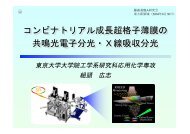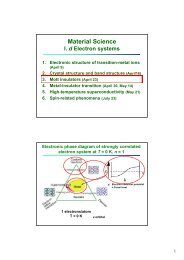Thesis High-Resolution Photoemission Study of Kondo Insulators ...
Thesis High-Resolution Photoemission Study of Kondo Insulators ...
Thesis High-Resolution Photoemission Study of Kondo Insulators ...
You also want an ePaper? Increase the reach of your titles
YUMPU automatically turns print PDFs into web optimized ePapers that Google loves.
104 Chapter 7. Temperature and Co-Substitution Dependence <strong>of</strong> the ...<br />
lowest panel <strong>of</strong> Fig. 7.6. 1 The spectral DOS thus obtained for FeSi and Fe1−xCoxSi<br />
are shown in Fig. 7.6. One can see that the energy range where the DOS vary with<br />
temperature is between EF and ∼ 50 meV below it, consistent with the data taken<br />
at room temperature and ∼10 K reported by Breuer et al. [7.8] The size <strong>of</strong> this wide<br />
dip or “pseudogap” is almost independent <strong>of</strong> the Co content. The pseudogap is wide<br />
enough compared with the instrumental resolution and therefore the present approach<br />
<strong>of</strong> dividing the spectra with the Fermi-Dirac distribution function is valid to discuss<br />
this structure. From the present PES spectra, however, one cannot conclude where the<br />
missing spectral weight in the pseudogap region is transferred. Here, it should also be<br />
noted that spectral weight around EF remains substantially high at all temperatures,<br />
contrasted with the optical conductivity data, in which almost all the spectral weight<br />
is depleted below ∼−60 meV at low temperatures. Comparing the data from single<br />
crystals and polycrystals, Breuer et al. [7.8] proposed that the surface might be metallic<br />
and contribute the observed spectral weight at and around EF .<br />
In Fig. 7.6 we note that the recovery <strong>of</strong> the DOS with temperature and with Co<br />
substitution is dependent on the energy position: we show in Fig. 7.7 the temperature<br />
dependence <strong>of</strong> the DOS at EF and 30 meV below it. Plotted are the intensities relative<br />
to the values at room temperature. The DOS at EF <strong>of</strong> pure FeSi increases with temperature<br />
more rapidly than those <strong>of</strong> Co-substituted samples. On the other hand, such<br />
a difference between the pure and Co-substituted samples is absent at −30 meV. This<br />
has already been suggested in Fig. 7.4, which shows that the Co substitution affects<br />
mainly the vicinity <strong>of</strong> EF . Here, we note that the recovery <strong>of</strong> the spectral function both<br />
at EF and 30 meV below it starts between 225 K and 150 K, low enough temperatures<br />
compared with the gap size. This is consistent with the temperature dependence <strong>of</strong><br />
the optical conductivity, where the gap feature disappears above ∼ 200 K. The bottom<br />
panel <strong>of</strong> Fig. 7.7 shows the dc conductivity <strong>of</strong> the samples studied here normalized to<br />
the values at room temperature. (The room-temperature conductivity <strong>of</strong> pure FeSi is<br />
∼ 75 % <strong>of</strong> those <strong>of</strong> the x = 0.05 and x = 0.10 samples.) Like the DOS at EF , the<br />
dc conductivity depends on Co content mainly below ∼ 200 K. Thus we can state<br />
1 On the other hand, one cannot discuss sharp structures compared with the energy resolution from<br />
these DOS thus obtained although sharp structures sometimes appear as spurious features. We have<br />
made extensive simulations for various DOS line shapes and temperatures in order to see to what<br />
extent the present method is reliable in extracting the original DOS. Figure 7.6 indicates temperaturedependent<br />
spectral changes in the wide energy range but from this figure alone one cannot exclude the<br />
possibility that a sharp gap compared with the energy resolution is opened near EF .






